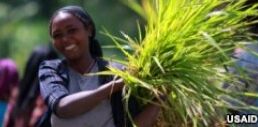正文
VOA常速英语:Next Phase of Feed the Future(翻译)
Hunger is a result of poverty, but it also causes poverty. People who do not have sufficient food and nutrition are less able to escape from poverty. In many countries women, although they do much of the farming, lack access to training, credit or land. Conflict, poor or corrupt management of natural resources, displacement of small farmers by natural disasters; and financial and economic crises that eliminate jobs at the lowest levels, all contribute to creating conditions that push the poorest into hunger.
To break this vicious cycle, the United States launched, in 2010, the Feed the Future Initiative, which aims to reduce global hunger, poverty, and undernutrition by focusing on smallholder farmers, increasing investments in agriculture and supporting country-owned plans for improving food security and nutrition while generating opportunities for economic growth and trade.
Back then, the U.S. Government selected 19 countries in Africa, Asia and Latin America to participate in the initiative, based on 5 criteria. Since 2010, Feed the Future has helped 9 million people living in the participating countries, pull themselves out of poverty.

The passage of the U.S. Global Food Security Act of 2016 endorsed Feed the Future's approach and ushered in a new era of U.S. Government global food security investment. A new, corresponding global food security strategy developed by the U.S. Government is guiding Feed the Future's work as the initiative enters its second phase.
On August 31st, USAID Administrator Mark Green announced that Bangladesh, Ethiopia, Ghana, Guatemala, Honduras, Kenya, Mali, Nepal, Niger, Nigeria, Senegal, and Uganda were selected to participate in this new phase of Feed the Future.
“With the selection of these 12 countries, the second phase of Feed the Future will be focusing its efforts on promoting long-term, sustainable development that brings partners together to help people harness the power of smart agriculture to jumpstart their local economies and lift themselves out of poverty,” said Administrator Green.
“By equipping people with the tools to feed themselves over the long term, Feed the Future is addressing the root causes of hunger and poverty. This long-term investment builds communities that are more resilient to drought, famine and other natural disasters, and less dependent on emergency food assistance.”
相关文章
- VOA常速英语:日增20万确诊病例,印度疫情失控
- VOA常速英语:美国驱逐10名俄罗斯外交官
- VOA常速英语:US Marks One Year of Pandemic Shutdown with Hope, Concern
- VOA常速英语:US Senate Nears Vote on $1.9 Trillion Biden COVID Aid Package
- VOA常速英语:What Is Clubhouse and Why Did It Get So Popular?
- VOA常速英语:Thermal Water Helps Recovering COVID Patients
- VOA常速英语:Deadly Drug Overdoses Epidemic Rages On
- VOA常速英语:International Women’s Day Marks Year of Increased Hardships for Women Worldwide
- VOA常速英语:US States Relax Restrictions, Health Officials Warn Against It
- VOA常速英语:Virginia Starts Reopening Schools for In-Person Learning




 手机网站
手机网站